As i mentioned a few days ago, the Barltett’s student show is one of my favourite events of the Summer in London. It is however so overwhelming and turbulent that you need dedication and pure chance to spot the works that might interest you the most.
I’m glad my Bartlett expedition led me to The Theatre of Synthetic Realities.
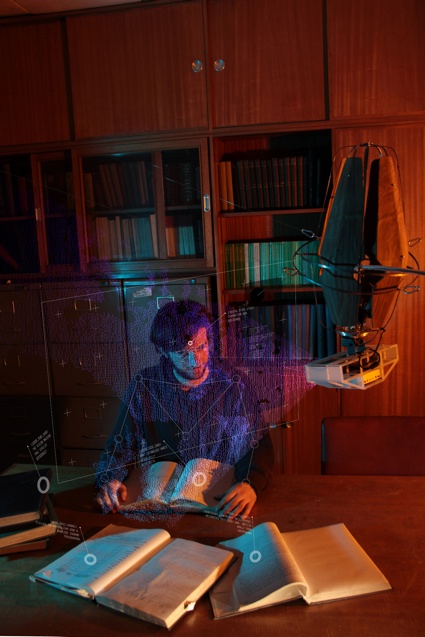
The project, authored by architectural designer Madhav Kidao, is miles away from what you’d expect from an architecture work. No model, no plan. In fact, it rather looks like an essay made of photos, short videos and texts. Together, they reflect on immoral architecture, unsympathetic machines, reality filtered by artificiality and more generally, our symbiotic relationship to technology. In fact, Kidao likens his project to “an exaggerated caricature of our present and near future relationships to technology as is stands.”
What made the project remarkable is its focus on how new technologies prompt new behaviour and new ethical questions and decisions. I realize i might be accused of heresy and crucified in front of the populace for writing this but ethics and social concerns are usually not the nerve centers of architectural exhibitions.
Allow me to do a bit of copy/pasting and let’s see each other right after that for an interview with Madhav Kidao.
The Theatre, as illustrated in the film Making Friends and Other Functions, is a vehicle in which to explore the relationship that exists between the designer/creator and his or her repertoire of increasingly intelligent collaborative tools, be these tools to create or tools to think. The machines, under the selective guidance of the designer, construct their own reality based upon the information they extract from their environment and its unwilling occupants. This is ultimately a task with no beginning or end, and fundamentally questionable ethical integrity. As result we are left to question the role of the Architect, both in regard to creative authorship and ethical responsibility.
Making Friends and Other Functions v.2 from Madhav Kidao on Vimeo.
Hi Madhav! What are the ‘Unsecure Webcams’ that are mentioned in ACT I – The Observer? What makes them unsecured?
As I’m sure you are aware most live feed web and surveillance cameras can be accessed remotely through the internet. It is possibly one of the Internet’s worst kept secrets that by simply googling specific codes for particular camera models, for example “intitle:liveapplet inurl:LvAppl” a list of all the live webcams of that particular make and model is given. Often, however, the owners of the cameras, usually domestic or small businesses, fail to password protect them, this is what makes them unsecured. Therefore in theory anybody is able to view the camera’s live stream and with many cameras actually control the pan and tilt of the camera. As long as you have not cracked any passwords, this is entirely legal.
Whilst the feeds are usually pretty innocent, and frankly often mundane, every now and then you come across something that you no doubt shouldn’t have done, an insight into a private world completely unconnected to our own other than through technology. It’s quite a peculiar relationship that exists between the remote observer and the realities of an unknown space that is unfolding before them. Time is of particular importance as you are viewing in real time a world in which you have no knowledge of its past beyond the moment you logged in, yet our extended embodiment into the animate camera somehow immediately embeds us into this unfamiliar space.
This is not too dissimilar to the tele-assistance relationship between a drone pilot and the drone. Initially we are completely ignorant of where and what it is we are looking at other than what can been interpreted from the point of view of the camera. It’s in our nature to be inquisitive, to people watch, and there is some perverse pleasure in trying to comprehend the events unfolding before us. However due to the lack of context more often than not this is simply educated speculation. The more I explored this strange paradigm the more I found myself just making up wholly fictitious scenarios in my head based upon the slightest clues garnered purely from body language, perceived interactions and the environment. The epistemologically variety of this action means that truth soon begins to seem irrelevant compared to the desire to fabricate an alternative reality.
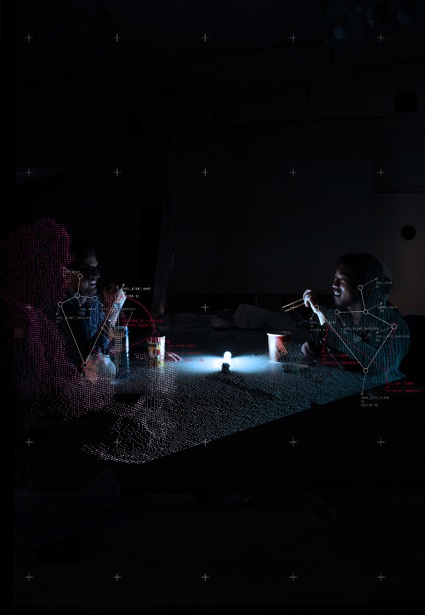 Machine Vision Portrait – Gesture Recognition
Machine Vision Portrait – Gesture Recognition
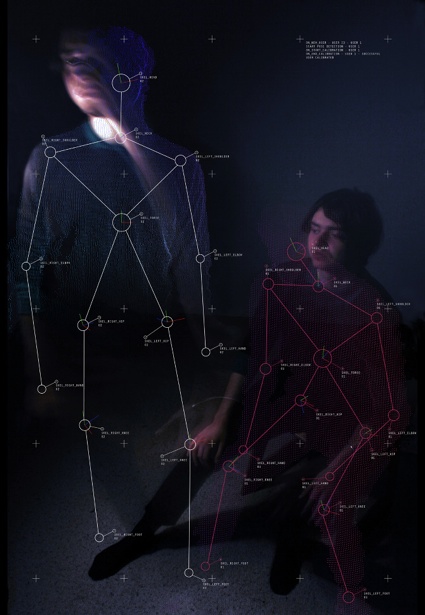 Machine Vision Portrait – Skeleton Tracking
Machine Vision Portrait – Skeleton Tracking
The name of the project, The Theatre of Synthetic Realities, places your work in the realm of fiction. Yet, it was inspired by elements of reality. Could you tell us about the trends, behaviors and technologies that have inspired the project?
It was from this point that the concept of a Theatre of Synthetic Realities emerged, a kind of reinterpretation of Hitchcock’s Rear Window for the 21st Century, in which the binoculars are replaced by the the vast interconnected complexity of our computing networks; with each input – be it a camera, a sensor or even another person – acting as a portal into a parallel environment. In much the same way as the binoculars are a prosthesis to extend our vision, the global technological systems that we symbiotically rely upon extend our powers of perception and influence around the world. In Rear Window the architecture of community and society defines the story. I was keen to explore how technology facilitates new forms of social interaction and redefined concepts of neighbourhood and community, and how this in turn redefines our concepts of architecture.
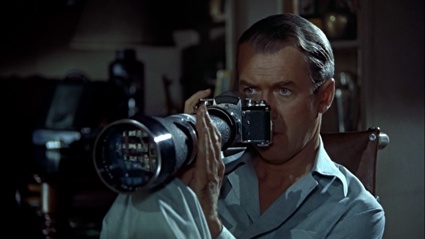 James Stewart in Hitchcock’s Rear Window, 1954
James Stewart in Hitchcock’s Rear Window, 1954
The impact technology has had upon our social systems, access to knowledge and global influence is nothing particularly new, Marshall McLuhan famously introduced the concept of a Global Village and Global Theatre almost 50 years ago. For me what is more interesting is how this has evolved into the relatively more recent concept of the Internet of Things. The trend I believe that we we will see with the Internet of Things is that it is not just objects that can be tagged and categorised but also the spaces they inhabit and the actions and events that they are associated with. In this way spaces, buildings and environments are becoming encompassed in the Internet of Things. This is not limited to architecture though, the social activities, and routines that are contained within that architecture add to the data history of a place, a form of artificial psychogeography. What this means is that in much the same way as we exist in a duality between physical and digital social circles, the spaces that we occupy do too. What we begin to see is a physical environment and the live updating digital representation of that environment. This is facilitated by new advances in sensory and scanning technologies, computer vision and biometric analysis.
I, like many others, was investigating the potential of the XBox Kinect as means of capturing complex real time data. Its capabilities have been widely publicised but in simple the idea that a machine can see in three dimensions and then also recognise human gesture is incredible. It allows any machine created using such technology to become actually embodied in a physical world. It begins to transcend the border between the physical and the digital which is a very powerful concept when thinking about intelligent environments. And as we increase our dependence upon the internet as our primary source of knowledge and interaction, our interpretation of truth becomes more reliant upon the technology that we assign to gather and interpret the real world. So fundamentally we start to view the physical world through the filter and perception of machines, in effect, a synthetic reality.
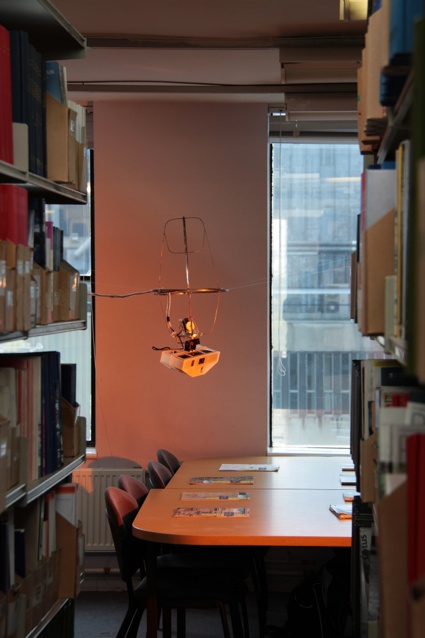 ACT III – The Vision Machine
ACT III – The Vision Machine
Could you describe the Vision Machine, the way humans would ‘interact’ with it and its ultimate purpose?
The idea of the Vision Machine originated from Paul Virilio‘s book The Vision Machine. In it he discusses the concept of the “automation of perception”, predicting a machine that sees for itself not for the benefit of man. This concept coupled with an interest in how artificial intelligence feeds into responsive/adaptive environments intrigued me. The capabilities that a computer has to extract a significant amount of information from a physical location combined with its ability to comparatively analyse that data with the vast amounts of data stored online through a neural network is almost enough to simulate perception. The resources that a computer has immediate accesses to – such as The Internet of Things – and its methods of analysis are completely alien to our own, therefore it could be predicted that its interpretations of the physical world would be alien too. Building upon the idea of how a human would perceive a space as viewed remotely through a webcam, I wanted to create a sensationalised demonstration of how the camera itself could possibly perceive the space it inhabits in relation to its learned perceptual world.
In regard to the Theatre of Synthetic Realities, the Vision Machine is in essence a robotic actor, cameraman and director in one. Whereas in the initial webcam scenario I was in complete control of the camera and was free to make my own conclusions of what I saw, with the Vision Machine at the other end I am relegated to a more collaborative role in which the machine dictates what it is I view however provides information that I would never have ordinarily been able to extract. Working from this principal we could then predict that the collaborative relationship between myself and the semi-autonomous machine could lead to an emergent performance unique to the relationship. The next stage in the Vision Machine was to then suggest that, much like I had done, it too begins to fabricate elements of reality and as such distort the reinterpretation of the digital model of that environment as well as what the viewer believes to be true.
The project has never really been a serious proposition for a machine to be developed. In fact it was supposed to be an exaggerated caricature of our present and near future relationships to technology as is stands. The machine is portrayed as more of a mild irritation that we just coexist with rather than any kind of interactive companion. Its ultimate purpose is as an analogical device to critique and explore our concept of what digital fabrication is or could be. In this project we are fabricating reality and the representation of reality as part of the Internet of Things. It is very much an attempt to question the relationship we have to tools and technology in a world in which we continue to transfer not just physical but increasingly cognitive faculties over to those tools. The is not seen to be necessarily a negative thing but rather an interrogation of the possibilities this presents, especially in regard to new forms of collaboration.
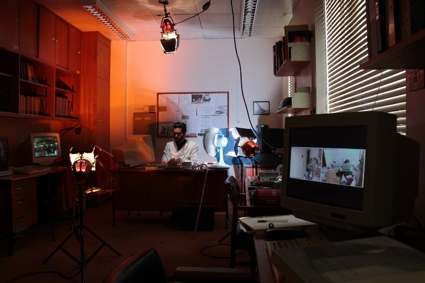 ACT IV – Making Friends and Other Functions
ACT IV – Making Friends and Other Functions
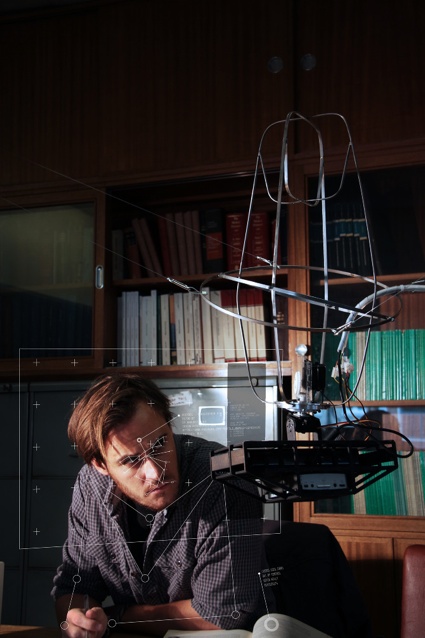 ACT IV – Making Friends and Other Functions
ACT IV – Making Friends and Other Functions
I found ‘ACT IV – Making Friends and Other Functions’ a bit daunting: here is a machine that observes human beings constantly and then assesses them and assigns them a character. Do you see current technology going in that direction? And what would be the benefit of having such machines around?
In Making Friends and Other Functions everything is real and works to some degree. Somethings I have exaggerated or simulated to communicate the ideas more coherently, however they are all based upon pre-existing technology, most of which is already incorporated into our smartphones. So rather than technology heading in that direction it is in fact already there. In fact casinos have been using some of the most advanced computer vision systems for sometime to catch out those attempting to cheat as well as identifying individuals who have been banned. But what I am more interested in is the relationships between the designer, society and emerging technology rather than necessarily a specific technology and its implications.
One of my aims for the project was to see how technologically advanced I could make it for the least amount of money; so begging, borrowing and hacking spaces, hardware, open source software and code. Then was an attempt to demonstrate how the role of the designer is changing, particularly in the world of open source projects. Practically any designer can now create they’re own tools and machines for any job-specific purpose with a relatively low budget, the RepRap being the archetype. As complex and powerful technologies become cheaper and easier to hack, like the Kinect, the designer is gifted with power and responsibility that is free from supervision.
That sense of malaise you have from the idea of camera watching and judging you is in large part due to your loss of control and empathy due to the unpredictable nature of a non-human agent. I think this is an issue that as designers, and particularly architects, we will have to address. As architecture reacts to shifts in social habits I think we will see a lot of unforeseen challenges in regard to what technologies we use and the manner in which we do so.
Fundamentally my project is an immoral one and I think the concept of an immoral architecture is something that will become increasingly prevalent in the future.
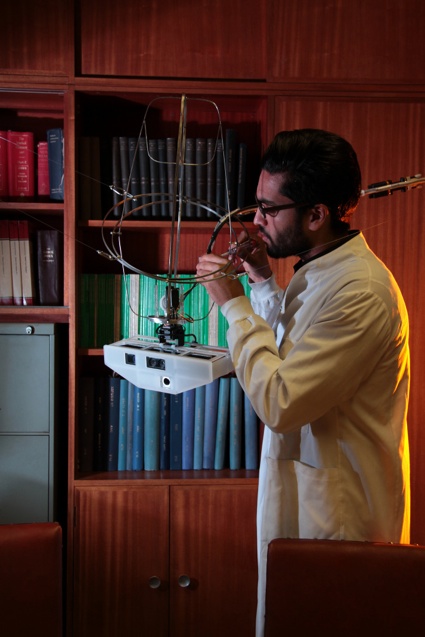 ACT IV – Making Friends and Other Functions
ACT IV – Making Friends and Other Functions
The text of your project says that “The Theatre (…) is a vehicle in which to explore the relationship that exists between the designer/creator and his or her repertoire of increasingly intelligent collaborative tools, be these tools to create or tools to think. The machines, under the selective guidance of the designer, construct their own reality based upon the information they extract from their environment and its unwilling occupants. This is ultimately a task with no beginning or end, and fundamentally questionable ethical integrity. As result we are left to question the role of the Architect, both in regard to creative authorship and ethical responsibility.” Is ethical responsibility already an issue architects and designers encounter nowadays when working with new technological tools?
Ethical responsibility has always had some part to play in the design process but I think that is slowly coming to the forefront. The explosion of open source has really brought ethics into the design process as it not only transfers power from the institution to the individual but it also provides new forms and channels to disseminate information, this recent article actually being a perfect example.
For me, consciousness and intent are just as important as categorical right and wrong. For exploring emergent technology is just that, emergent, it is unknown. While a particular technology may have positive society changing impact it may well have dire consequences too. I’m not one for speculations upon utopian ideals and believe that we will have to tread and adjust the boundary of what is acceptable to progress civilisation, however whilst the unquestioning embrace and exploration of new technology is exciting we often fail to question its merit beyond novelty. As Joseph Weizenbaum suggested, just because we can do something doesn’t mean we ought to. I think we have to take a utilitarian stance and ask ourselves is doing something in a new way beneficial to design and society? And if so is it not to the detriment of others?
Admittedly I think architecture is a bit slow off the mark when it comes to these kinds of issues. This is understandable when you consider the timescale architecture operates on compared to other design fields. However Architects have always been eager to incorporate new design methodologies and the ethics of the technology used will undoubtedly become an issue.
In terms of the Bartlett show, I’m guessing there is a particular reason you have asked this question so I would ask the same of you. The show is always a dazzling array of phenomenal work and the mastery of a variety of mediums used is breathtaking. I do feel the density and complexity of the show does however sometimes make it overwhelming and distracting from the work. Of course as with any degree show the work on display can only ever be a vast reduction of the full scope of the project and as such the viewer is never going to get a comprehensive understanding of that project.
Thanks Madhav!
All images Madhav Kidao.
